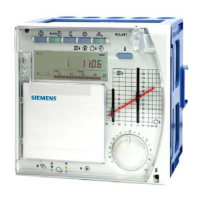73/118
Siemens Heating and D.h.w. Controller RVL481 CE1P2541en
Building Technologies 19 Function block "D.h.w. storage tank" 20.05.2008
19.7 Forced charging
On operating line 131, it is possible to select whether or not forced charging of the
d.h.w. storage tank shall take place daily when d.h.w. heating is released for the first
time. With forced charging, the d.h.w. storage tank will also be charged when the d.h.w.
temperature lies between the switch-on and the switch-off temperature. The switch-off
point remains the same.
If d.h.w. heating is released 24 hours a day, forced charging takes place every day at
midnight. If activated, the legionella function also leads to forced charging.
19.8 Protection against discharging
19.8.1 Purpose
With plant types using a d.h.w. storage tank, protection against discharging is ensured
during overrun of the d.h.w. charging pump. This function makes certain that the d.h.w.
will not be cooled down again during pump overrun.
19.8.2 Mode of operation
If the flow temperature is lower than the d.h.w. storage tank temperature,
• pump overrun will be terminated prematurely (plant types x–1, and x–2)
• the changeover valve will be driven to the position "Heating circuit” (plant types x–3)
If the storage tank is equipped with two sensors, the sensor measuring the higher tem-
perature is considered.
The flow temperature is acquired with sensors B1 and B3, depending on the type of
plant, or obtained from the data bus (LPB) as the common flow temperature.
If the flow temperature is lower than the setpoint of the d.h.w. temperature,
• pump overrun will be terminated prematurely (plant types x–1, and x–2)
• the changeover valve will be driven to the position "Heating circuit” (plant types x–3)
The flow temperature is ascertained as follows, depending on the type of plant and the
bus connection:
Plant
type
Controller with no bus (LPB) Controller with bus (LPB)
1–1 No protection against dis-
charging
Common flow temperature from data bus
(if present), otherwise no protection
against discharging
1–2 Sensor B3 Sensor B3
2–1 Sensor B1 Sensor B1
2–2 Sensor B3 Sensor B3
2–3 Sensor B1 Sensor B1
3–1 Sensor B1 Sensor B1
3–2 Sensor B3 Sensor B3
3–3 Sensor B1 Sensor B1
4–1 Sensor B1 Sensor B1
4–2 Sensor B3 Sensor B3
5–1 Sensor B1 Sensor B1
5–2 Sensor B3 Sensor B3
6–1 Sensor B1 Sensor B1
6–2 Sensor B3 Sensor B3
With storage tank
sensor(s)
With thermostat(s)
Flow temperature

